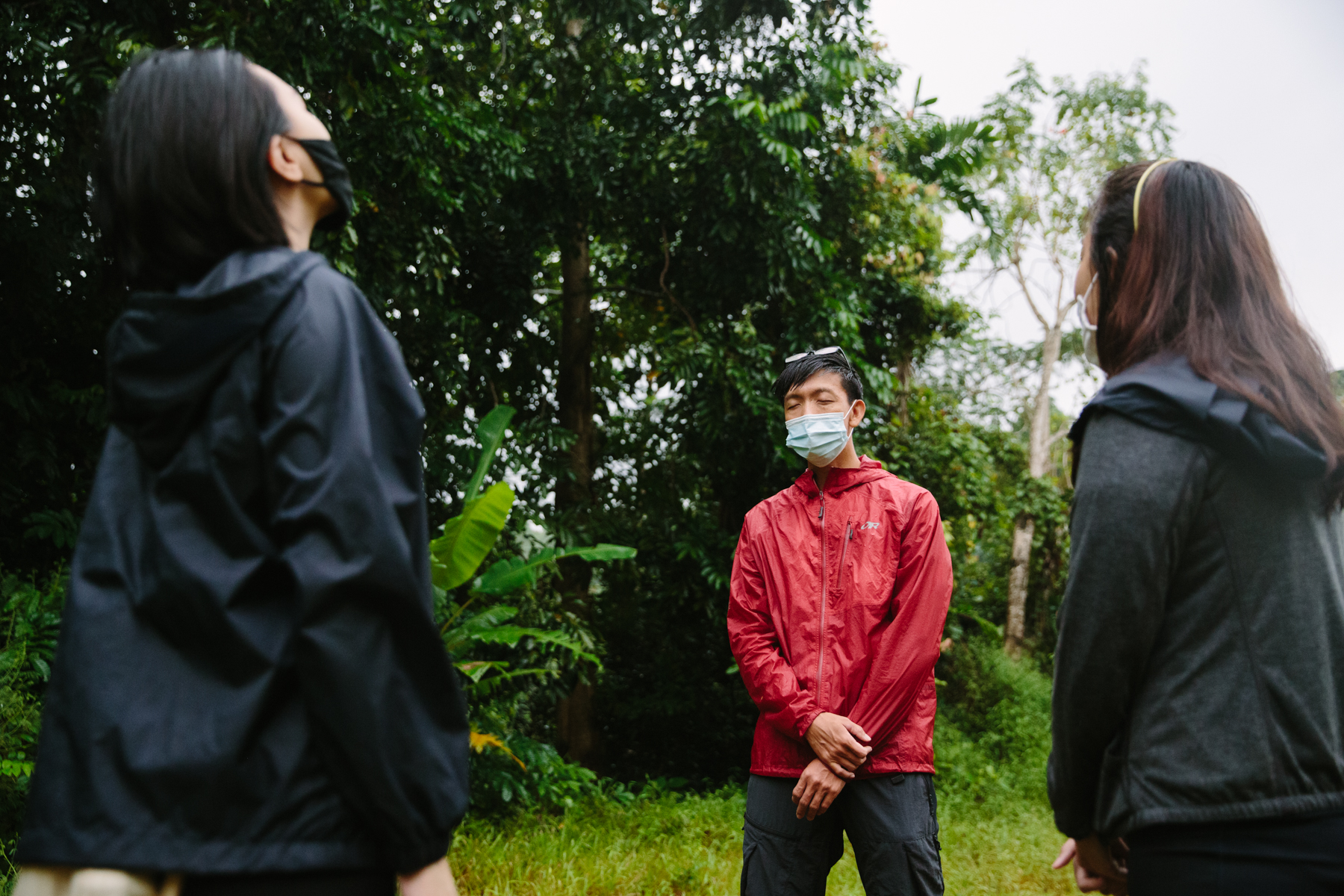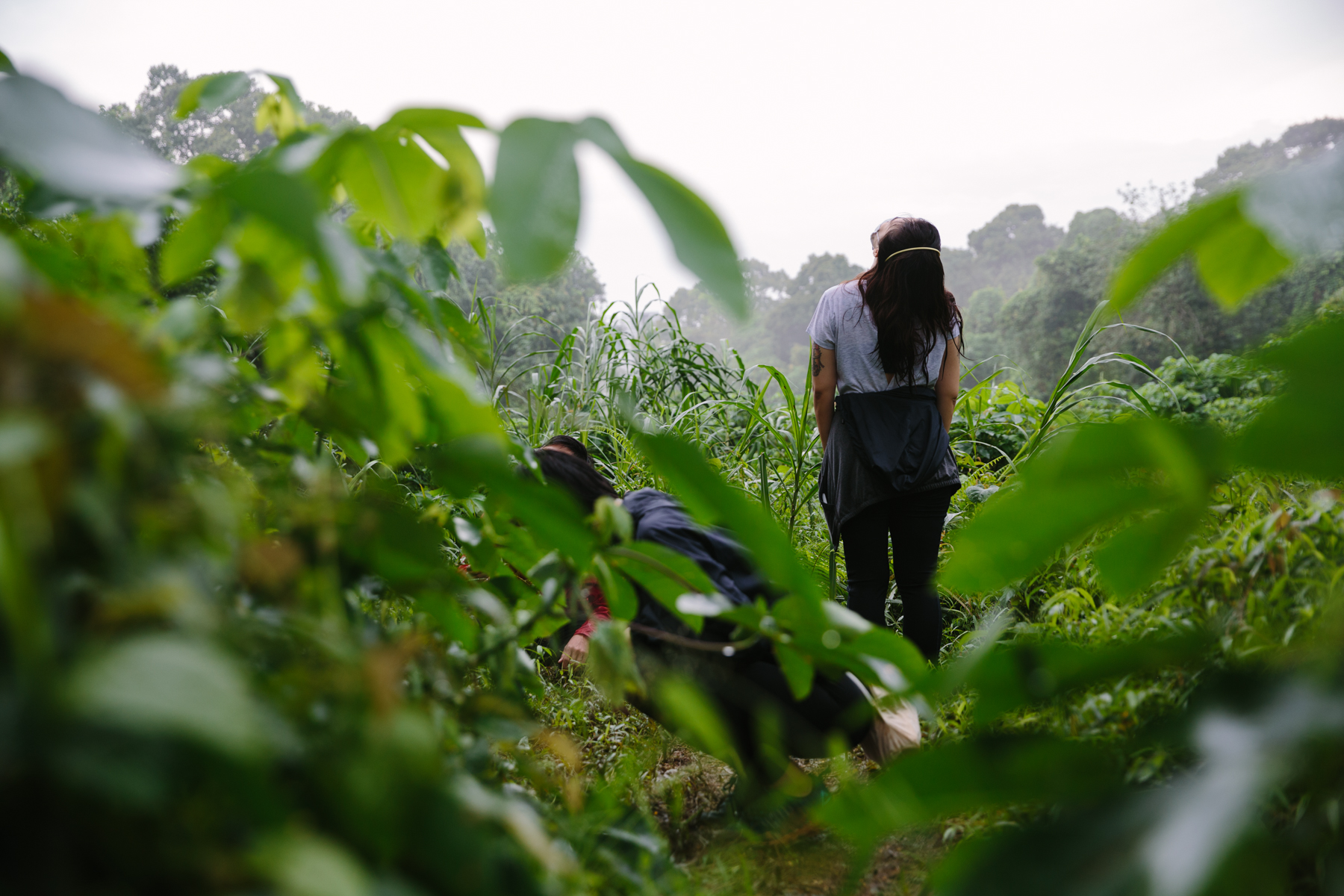It was 6:30 a.m., pitch dark, raining heavily, and I’m half asleep, trekking through a dense, muddy jungle in Clementi Woods, one of Singapore’s most pristine — yet unprotected — forests.
Our guide Kian broke the silence to tell me and two others in our group about a sweet little spot he found off the beaten track, where we can do what we were all there for — shinrin yoku, or forest bathing.
Videos by VICE
“Embrace your senses and be mindful,” he said. “In the meantime, just take a moment to smell and enjoy the rain and observe our surroundings in silence. I promise it’ll be worth it.”
Originating in Japan during the 1980s, the art of forest therapy has become a vital part of preventative healthcare in the country. Noticing rising stress levels that came with its rapid urbanization, the Japanese government began encouraging citizens to take walks in the forests and immerse themselves in nature.
And over the years, studies have shown that forest bathing has tangible benefits on mental health. Researchers recorded the strengthening of immune systems, lowered stress, aggression, and anxiety levels, and even positive effects on people experiencing depression. In short, it could make you happier.
Despite recent developments on vaccines, COVID-19 will likely still be around for a long time. And after spending months in lockdown, both my mind and body have adjusted to a sedentary indoor lifestyle. I have now become so conditioned to the idea of staying indoors, away from germs and other people. I reveled in it for months, not only because it allowed me more downtime, but because it also provided a sense of psychological security.
But while I’ve learned to embrace this quieter — and safer — way of living, there is always that nagging feeling reminding me that I will eventually have to return to the outside world. And, more importantly, will need a change in scenery for my own good.
I thought about all of this as I trekked through the forest, stepping on mud and leaves, and brushing aside branches. I struggled to keep up with Kian and the rest of the group.
Being back in nature was overwhelming. I wasn’t used to my legs working so much. Touching plants I came across felt almost weird. But the smell of the rain and the fresh, clean air was so good.
And most of all, I noticed for the first time in months that I didn’t feel tired.
We all know how good nature can make us feel. Before the pandemic hit, medical experts and researchers have always encouraged people to spend more time outdoors, saying that exposure to nature not only makes us feel better emotionally, it contributes to our physical wellbeing too. But my question was, will forest bathing in Singapore — where there aren’t a lot of remaining forests to begin with — actually work?

“Listen to the forest,” Kian said when we reached our first destination, a little clearing in the woods surrounded by sprawling grassy fields and enormous trees.
He began the forest bathing session by inviting us to “open our senses” to the green surroundings, to take in the sights, sounds, and smells.
The morning air was crisp and fresh.
Birds were singing and crickets were chirping in tune with dozens of frogs hidden from sight, who were croaking, probably happy because of the light rain. I could see sunlight streaming in through the trees.
“In forest bathing, the forest is your therapist,” Kian told us.
“It’s all about being mindful and present, observing and appreciating nature. There are no limitations to this practice.”

A busy mind can be an overwhelming place to live. Many people, including my psychiatrist, have recommended meditation to me, but I’ve never been able to master it. Yoga doesn’t do it for me either. But simply being in the forest, not jogging or hiking or cycling, felt really easy — and I liked it. I didn’t think about my phone or worries for the day ahead.
I was finally living in the moment, still technically in the city but very much away.
We roamed around in silence, careful not to venture too far off track. Kian encouraged us to explore our surroundings and to focus on sensory elements like touch and movements. “All part of the experience,” he said.
We were allowed to pick up only fallen objects like rocks, flowers, leaves, and seeds, so as not disturb “the balance” of the forest. We could also take off our shoes if we wanted to, to feel the soft, wet grass. I didn’t because it was too muddy, but I see how that could have been relaxing.
“We take a lot from nature,” Kian said as he picked up a fallen fern leaf on the ground. “We’re lucky to still have green spaces in Singapore where we can experience pristine forest environments like this. But we have to be mindful in doing so in a respectful manner, without damaging the forest and leaving too many footprints.”
A typical group session lasts for two hours, Kian said, but can go on longer if one chooses. Before we knew it, we were in a green valley that used to be a riverbed.
Marianne Tan, another participant in our forest bathing group, bent down to dip her fingers in a small clear stream and noticed bubbles forming. “It’s wild,” she said. She has dealt with depression for years and, like me, hadn’t been out much since the pandemic hit. This was her first time back out in nature and she liked it. “It’s a really great way to slow down. Whatever you feel is what you feel. Just watch and observe, it’s as simple as that.” Forest bathing seems to be catching on in Singapore and other parts of Asia.
We ventured onto another trail through thick bushes and spotted wild Monstera plants, which have grown to gargantuan sizes. Kian heard our laughter and excited squeals, and shared a story about how he once guided a group of patients affected by OCD at a park.
“Some of them were a bit hesitant to touch things and it was understandably so,” Kian said. “It took them a little while to get comfortable with the surroundings but they got there and were really happy being present — I could see the positive effects that nature was having on their mental wellness.”

The good news is that you can forest bathe anywhere, according to experts, from national parks to neighborhood ones — even from the comfort of your urban balcony or garden. You just need a place to settle yourself and enjoy nature. I hadn’t gone hiking in majestic mountains or parks for a long time, so I wanted to go big and challenge myself.
A lot of the terrain in Clementi forest was harsh to navigate but I quickly developed a sense of calm and confidence to make it through the dense jungle. I even helped others cross over muddy ledges along the way.

We came across a river stream and followed it to the final stretch of our virgin forest bathing experience. We observed the rest of the trail in silence, feeling our way through vines and fallen tree trunks while being careful not to step over insects or damage more parts of the forest. It took us around 20 minutes to regroup, and then were greeted by a delicate Japanese tea set for our final sharing session.

Self-care comes in different forms and when it comes to finding inner peace and calm, there isn’t a one-size-fits-all solution. It varies from person to person.
Some people love bubble baths and face masks. Music and art therapy may work for others. But if you love nature and being outdoors, then the effects of forest bathing will be more beneficial and powerful.
“It doesn’t matter if you do it with a guide or on your own,” Kian said.
He ended our session by pouring out hot green tea into ceramic cups, much welcomed after the morning’s early rainstorm.
“Forest bathing celebrates nature and eases mental stress. The magic lies in the simplicity of it — just being on your own, being mindful, and switching off from regular life.”
I don’t know if I’ll be able to recreate the magic I experienced that morning. The peace and tranquility the forest had to offer was healing on its own. But I do know that reconnecting with nature in a way that I hadn’t done so in months left me wanting more.




